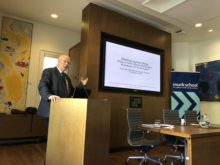On Friday, 11 October 2019, the Centre for European, Russian, and Eurasian Studies (CERES) was pleased to welcome Prof. Col. Winfried Heinemann – a respected military historian and retired officer of the German Armed Forces (Bundeswehr) – back to the University of Toronto to lead a student seminar on the history of the Berlin Wall. Prof. Heinemann, who has visited CERES several times previously, also presented a lecture to mark the 75th anniversary of Operation Valkyrie, the failed 20 July 1944 assassination plot against Hitler.
To begin his presentation, Professor Heinemann showed students a photo of a street in West Berlin featuring a large church at the street’s end. The street, it turns out, once marked the boundary between two of Berlin’s many constituent neighbourhoods and was later used as part of the border between the British and American sectors during the Cold War division of the city. Because those sectors belonged to two of the Western Allies, the church stayed safely in place, straddling the street. But along the border between the eastern and western halves of the city, it was a different story: the Versöhnungskirche (Church of Reconciliation), which happened to stand on the Bernauer Straße along the border between East and West Berlin, was bricked up when the Wall was initiated in 1961. It was eventually demolished in 1985 at the direction of the dictatorship of the German Democratic Republic (GDR).
The Berlin Wall began as a fairly straightforward border-control measure to prevent East German citizens from fleeing the GDR and to pressure Western Allies into relinquishing their access rights to West Berlin. The “Wall,” originally composed of barbed wire and haphazardly stacked concrete blocks, was not intended to serve as a long-term, permanent partition. But after it became clear that the Allies did not intend to cave in, the East German government gradually installed more sophisticated, more elaborate elements to fortify the border.
Professor Heinemann further explained that the Berlin Wall known to most Westerners is not a complete representation of what the Berlin Wall was. In fact, the idea of the “Wall” became popular largely in the West, whereas those in East Germany commonly referred to it as the “border.” Beyond the concrete slabs seen from West Berlin in later years, the citizens of the GDR saw a complex of deterrence made up of reinforced mesh fencing, anti-vehicle trenches, barbed wire, and 116 watchtowers. Despite the Wall’s collapse in 1989, large remnants can still be seen in Berlin. Visitors to the capital can also trace the wall’s former path through much of the city by following inset plaques placed in the ground that mark the border’s former positions.
Following Professor Heinemann’s presentation, he led a lively discussion that examined GDR’s other border measures around West Berlin’s outer perimeter as well as those used on the “inner-German” border between East and West Germany. These lesser known “walls” had a major impact on life in the two German states but are often forgotten in (foreign) popular imagination. While these border measures were less prominent and severe than the wall running through Berlin – they generally resembled fences rather than a heavily guarded border – they were still patrolled carefully and kept East Germans inside the GDR.
In a nod to the seminar’s location, Prof. Heinemann and the students also discussed the links between the divided Germanies, NATO, and the legacy of Lester B. Pearson, especially the important role he played in the development of the modern concept of peacekeeping. During the Cold War, Canada contributed armed forces to many peacekeeping missions around the world, including locations, such as Germany, that served as the front lines dividing communist and anti-communist forces.
CERES students are already planning research projects that will incorporate material from this seminar, including papers on the cultural divides created by the Berlin Wall and the strain it had, and continues to have, on interpersonal relations. Another planned project will investigate potential links between the history of refugees in divided Berlin and the ways in which the city has dealt with the influx of refugees in recent years.
by Tami Piovesan, CERES MA candidate
